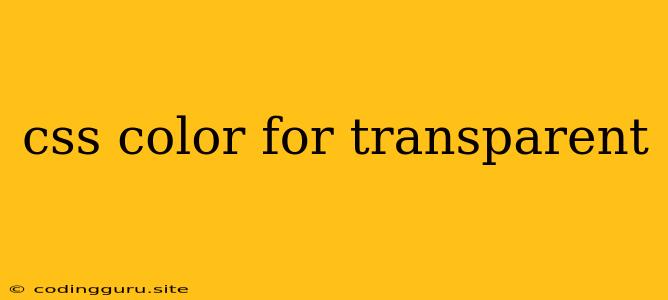CSS Color for Transparent: A Comprehensive Guide
Have you ever wanted to create a website element that's partially visible, allowing you to see through it to the content behind it? This is where CSS color for transparent comes in. It's a powerful technique that lets you control the opacity of your elements, creating a range of visually interesting effects.
What is Transparency?
Transparency in CSS refers to the ability to make an element partially or fully see-through. This is achieved by using the opacity property, which takes a value between 0 and 1.
- 0: Completely transparent (invisible)
- 1: Completely opaque (fully visible)
- 0.5: 50% transparent (half visible)
How to Use Transparent Colors in CSS
There are a few different ways to implement transparent colors in your CSS:
1. Using the rgba() Function:
The rgba() function lets you specify a color with its red, green, blue (RGB) values and an alpha channel for transparency. The alpha channel takes a value between 0 and 1, representing the opacity.
Example:
.transparent-box {
background-color: rgba(255, 0, 0, 0.5); /* Red with 50% transparency */
}
This will create a red box that is 50% transparent.
2. Using opacity Property:
The opacity property directly controls the transparency of an element. It can be applied to any HTML element, and it affects all child elements within that element.
Example:
.transparent-text {
opacity: 0.7; /* Text with 70% transparency */
}
This will make the text within the element 70% transparent.
Using Transparency in Your Designs
Here are some creative ways to use transparency in your web designs:
- Create Overlays: Use transparent backgrounds for navigation menus, pop-up windows, or image overlays to create subtle visual effects.
- Highlight Text: Make text partially transparent to emphasize specific words or phrases within a larger block of text.
- Create Visual Depth: Use transparency to create layers in your design, giving the illusion of depth.
- Show Hints: Use transparent overlays with text to display helpful hints or instructions.
- Design Interactive Elements: Use transparency to create hover effects or highlight elements on mouse-over.
Considerations for Using Transparency:
- Readability: Be careful not to use too much transparency, as it can make text difficult to read.
- Performance: Overusing transparent elements can impact website performance, so use them sparingly.
- Accessibility: Consider how transparent elements may affect users with visual impairments. Provide alternative text descriptions or use contrasting colors to ensure accessibility.
Conclusion
CSS color for transparent is a powerful tool for creating visually appealing and interactive web designs. By understanding how to use the rgba() function and the opacity property, you can create transparent elements that enhance your website's aesthetics and user experience. Experiment with different levels of transparency to achieve the desired effects and remember to consider the impact on readability and accessibility.
